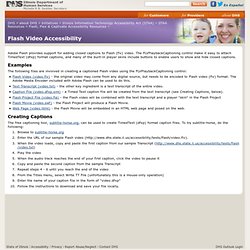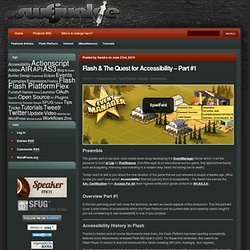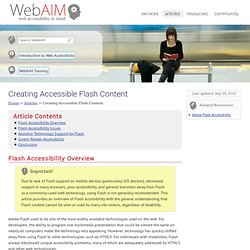

Flash Video Accessibility. Adobe Flash provides support for adding closed captions to Flash (flv) video.

The FLVPlaybackCaptioning control make it easy to attach TimedText (dfxp) format captions, and many of the built-in player skins include buttons to enable users to show and hide closed captions. Examples The following files are involved in creating a captioned Flash video using the FLVPlaybackCaptioning control: Flash Video (video.flv) - the original video may come from any digital source, but needs to be encoded to Flash video (flv) format. The Adobe Media Encoder included with Adobe Flash can be used to do this. Creating Captions The free captioning tool, subtitle-horse.org, can be used to create TimedText (dfxp) format caption files. Catalogue Flash Accessible - Comment Choisir - E-Accessibility Ppt.. Flash & The Quest for Accessibility – Part #1. Flash & The Quest for Accessibility – Part #1 Preamble The greater part of last year i was heads-down-busy developing the EventManager Game which i had the pleasure to build at Liip for Postfinance.

EventManager is an educational but fun game, that approaches topics such as budgeting, financing and investing in a modern way (read: not boring you to death). Today i want to talk to you about the new iteration of the game that we just released a couple of weeks ago. What is new you ask? Overview Part #1 In this two-part blog post i will cover the technical, as well as overall aspects of this endeavour.
Accessibility History in Flash Thanks to Adobe (and of course Macromedia back then), the Flash Platform has been sporting accessibility features since Macromedia released Flash MX back in 2002. Over the years obviously the feature set has vastly improved and Adobe (rightly so) can be proud of the level of accessibility that the Platform has today, since it allows you to: The Challenge Conclusion. Accessibility in Flash bug and issue list. Flash And Accessibility. As the Web has evolved, new software and applications have been developed for use on Websites.

Many of these new applications are proprietary products that don’t use standard features recognised by the World Wide Web Consortium (W3C). The use of non-standard formats can cause significant accessibility problems for some people. “Use W3C technologies (according to specification) and follow accessibility guidelines. Where it is not possible to use a W3C technology, or doing so results in material that does not transform gracefully, provide an alternative version of the content that is accessible.
Many non-W3C formats (e.g., PDF, Shockwave, etc) require viewing with either plug-ins or stand-alone applications. This Accessibility Guideline is probably one of the most contentious and difficult to interpret. Accessibility and Usability of Flash for Users with Disabilities. Learn techniques for designing websites for people with visual and motor impairments who use assistive technology, including: Screen readers Braille readers Screen magnifiers The information in this report is based on empirical observation of people who are blind, have low vision, and have motor impairments use websites and intranets.

Optimize the user experience by applying the guidelines discussed in this report along with technical accessibility standards. Following technical standards alone does not ensure usability. This report offers usability tips for ensuring ease of use and increased productivity. This 148-page report presents 75 design guidelines for creating websites for people who use assistive technology for browsing websites.
Topics covered Types of sites tested Research Method The information in this report is based on usability studies conducted with people with and without disabilities (control group). Research Reports Articles. Creating Accessible Flash Content. You are here: Home > Articles > Creating Accessible Flash Content Flash Accessibility Overview Important!

Due to lack of Flash support on mobile devices (particularly iOS devices), decreased support in many browsers, poor accessibility, and general transition away from Flash as a commonly-used web technology, using Flash is not generally recommended. This article provides an overview of Flash accessibility with the general understanding that Flash content cannot be seen or used by many site visitors, regardless of disability. Adobe Flash used to be one of the most widely available technologies used on the web.
Because of the multimedia nature of Flash, it can be used to deliver content through many mediums: graphics, text, video, audio, etc. Multi-modality: Flash can provide content in multiple ways, such as text, video, and audio simultaneously. Accessibility Resource Center.